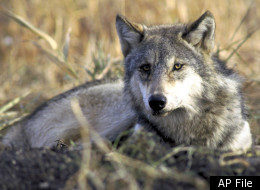Eastern Wolves Are Hybrids With Coyotes: Study
By MARY ESCH
05/31/11 03:09 PM ET

ALBANY, N.Y. -- Wolves in the eastern United States are hybrids of gray wolves and coyotes, while the region's coyotes actually are wolf-coyote-dog hybrids, according to a new genetic study that is adding fuel to a longstanding debate over the origins of two endangered species.
The study is unlikely to impact the management of the endangered red wolf in North Carolina and the eastern Canadian wolf in Ontario, but it offers fresh insight into their genetic makeup and concludes that those wolves are hybrids that developed over the last few hundred years.
Some scientists have argued that the red wolf, Canis rufus, and the eastern Canadian wolf, Canis lycaon, evolved from an ancient eastern wolf species distinct from the larger gray wolf, Canis lupus, that is found in western North America.
Wolf experts who adhere to that theory say the new study is interesting but falls short of proving anything. They say it doesn't explain why hybrids appear only in some places and note that western wolves don't hybridize with coyotes but often kill them.
In the study, published online earlier this month in the peer-reviewed journal Genome Research, 16 researchers from around the globe led by Robert Wayne of the University of California-Los Angeles, used information from the dog genome – the animal's entire genetic code – to survey the genetic diversity in dogs, wolves and coyotes.
It was the most detailed genetic study of any wild vertebrate species to date, using molecular genetic techniques to look at over 48,000 markers throughout the full genome, said Roland Kays, curator of mammals at the New York State Museum and a co-author.
In a previous study of the dog genome published last year in the journal Nature, a Wayne-led international team of scientists reported that domestic dogs likely originated in the Middle East and shared more genetic similarity with Middle Eastern gray wolves than any other wolf population.
The recent study showed a gradient of hybridization in wolves.
In the West, wolves were pure wolf, while in the western Great Lakes, they averaged 85 percent wolf and 15 percent coyote. Wolves in Algonquin Park in eastern Ontario averaged 58 percent wolf.
Northeastern coyotes, which only colonized the region in the past 60 years, were found to be 82 percent coyote, 9 percent dog and 9 percent wolf.
In a study co-authored by Kays last year in the journal Biology Letters, museum specimens and genetic samples were used to show that coyotes migrating eastward bred with wolves to evolve into a larger form that has become the top predator in the Northeast, filling a niche left when native eastern wolves were hunted out of existence. The hybridization allowed coyotes to evolve from the scrawny mouse-eaters of western grasslands to robust deer-hunters in eastern forests.
The genetic techniques used in the recent study allowed researchers to estimate that hybridization, in most cases, happened when humans were hunting eastern wolves to extinction, Kays said.
"The few remaining animals could find no proper mates so took the best option they could get," Kays said.
L. David Mech, senior research scientist at the U.S. Geological Survey's Northern Prairie Research Center in St. Paul, Minn., and founder of the International Wolf Center in Ely, Minn., is skeptical of the theory that eastern wolves are hybrids.
"How do you reconcile this with the fact that gray wolves typically don't breed with coyotes, but kill them?" Mech said. "We have no records in the West of wolves hybridizing with coyotes, even in areas where single wolves looking for mates have dispersed into the middle of coyote country."
Mech also questioned whether the study tested enough Canadian and North Carolina wolves and whether those specimens were true representatives of those populations.
Although 48,000 genetic markers sounds like a lot, it's actually a relatively small part of the entire genetic code, Mech said. So the evidence of a unique eastern wolf ancestor could simply be in another part of the code that wasn't analyzed, he said.
Several researchers who consider the eastern wolf species separate from the gray wolf weighed in recently in an online discussion of the new study.
Brent Patterson, a genetics researcher at Trent University in Peterborough, Ontario, called the study "an important step forward." But until more samples are analyzed, the hypothesis that a North American wolf evolved independently from the gray wolf was still viable, he said.
"It's an academic issue," Mech said. "It's nice to know what the origins are from the standpoint of curiosity, but from a conservation standpoint, it shouldn't make any difference."
David Rabon, coordinator of the U.S. Fish and Wildlife Service's Red Wolf Recovery Program in North Carolina, said the federal agency has taken the position that the red wolf is a unique species that warrants protection. The new study, while interesting, won't likely change management decisions, he said.
Source

